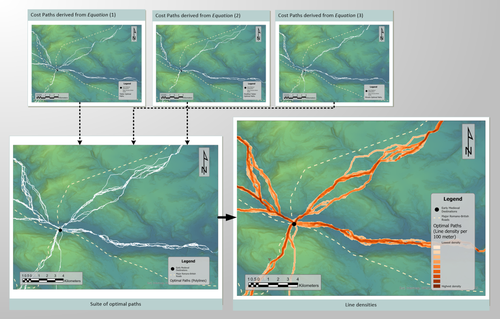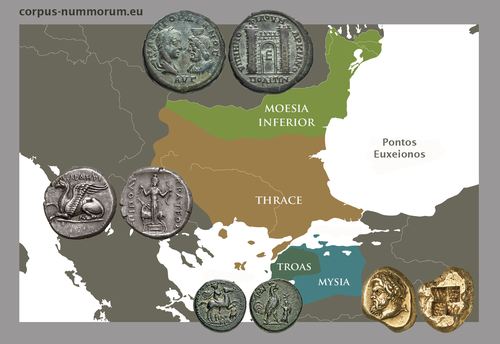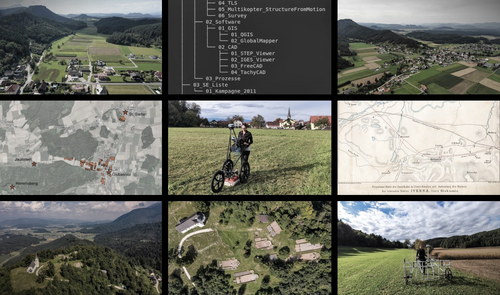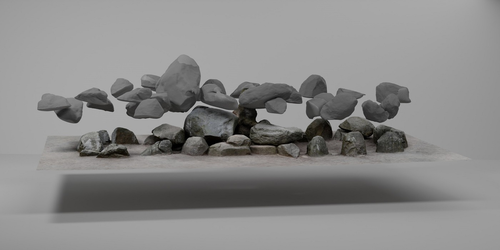
VISSER Ronald
- School of Business, Building and Technology, Saxion University of Applied Sciences, Deventer, Netherlands
- Antiquity, Archaeometry, Bioarchaeology, Computational archaeology, Dating, Europe, Spatial analysis
- recommender
Recommendations: 3
Review: 1
Recommendations: 3

Mobility and the reuse of Roman Roads for the deposition of Viking Age silver hoards in North West England
Moving away from the ritual deposition: hoards from the Viking Age, Least Cost Paths and reused Roman Roads
Recommended by Ronald Visser based on reviews by Sam Leggett and Scott MadryI had the pleasure of reading ‘Mobility and the reuse of Roman Roads for the deposition of Viking Age silver hoards in North West England’ by Wyatt O. Wilcox (Wilcox 2024a). It is an honour to recommend this paper. The aim of this study is to research the relationship of 18 Viking Age hoards and their transport and depositional locations. This is studied in relation to the Roman road network and the landscape using least cost path analyses. Single finds from the Portable Antiquities Scheme (https://finds.org.uk/) are also incorporated in the study. The study deals with the distance of these Viking Age finds to these roads/least-cost-paths and the final interpretation moves away from ritual interpretation of these finds to a more mundane explanation. I feel that this could potentially open discussion also for hoards from other periods.
While both reviewers (Sam Leggett and Scott Madry) presented various suggestions to improve the first submitted version of the paper, the author has done a tremendous job to improve the paper based on the comments and even beyond these comments. The author has also deposited the Jypiter-notebook online (Wilcox 2024b), showing that he is contributing to Open Science. The first version of the dataset has been improved and updated based on the comments by the reviewers and me, improving the reproducibility of the analyses. All in all, this paper has improved and I am very glad that I can recommend this for publication, and I’d like to do so with a sentence from the review by Sam Leggett:
“this study has a lot of potential to be deployed across other regions, and time periods for similar purposes (Iron Age hoards for instance). And it will be of great interest to Viking Age experts interested in hoards, but also early medieval transport and travel.”
References
Wilcox, W. 2024a Mobility and the reuse of Roman Roads for the deposition of Viking Age silver hoards in North West England. Zenodo, 7999149, ver. 5 peer-reviewed and recommended by Peer Community in Archaeology. https://doi.org/10.5281/zenodo.7999149
Wilcox, W. 2024b Mobility and the reuse of Roman Roads for the deposition of Viking Age silver hoards in North West England (Supplemental Material). https://doi.org/10.5281/zenodo.11067607

CORPUS NUMMORUM – A Digital Research Infrastructure for Ancient Coins
The valuable Corpus Nummorum: a not so Little Minion
Recommended by Ronald Visser based on reviews by Fleur Kemmers and 1 anonymous reviewerThe paper under review/recommendation deals with Corpus Nummorum (Peter et al. 2024). The Corpus Nummorum (CN) is web portal for ancient Greek coins from various collections (https://www.corpus-nummorum.eu/). The CN is a database and research tool for Greek coins dating between 600 BCE to 300 CE. While many traditional collection databases aim at collecting coins, CN also includes coin dies, coin types and issues. It aims at achieving a complete online coin type catalogue. The paper is not a paper in a traditional sense, but presents the CN as a tool and shows the functionalities in the system. The relevance and the possibilities of the CN for numismatists is made clear in the paper and the merits are clear even for me as a Roman archaeologist and non-numismatist.
The CN was presented as a poster at the CAA 2023 in Amsterdam during “S03. Our Little Minions pt. V: small tools with major impact”, organized by Moritz Mennenga, Florian Thiery, Brigit Danthine and myself (Mennenga et al. 2023). Little Minions help us significantly in our daily work as small self-made scripts, home-grown small applications and small hardware devices. They often reduce our workload or optimize our workflows, but are generally under-represented during conferences and not often presented to the outside world. Therefore, the Little Minions form a platform that enables researchers and software engineers to share these tools (Thiery, Visser and Mennenga 2021). Little Minions have become a well known happening within the CAA-community since we started this in 2018, also because we do not only allow 10-minute lightning talks, but also spontaneous stand-up presentations during the conference. A full list of all minions presented in the past, can be found online: https://caa-minions.github.io/minions/. In a strict sense the CN would not count as a Little Minion, because it is a large project consisting of many minions that help a numismatist in his/her daily work. The CN seems a very Big Minion in that sense.
Personally, I am very happy to see the database being developed as a fully open system and that code can be found on Github (https://github.com/telota/corpus-nummorum-editor), and also made citable with citation information in GitHub (see https://citation-file-format.github.io/) and a version deposited in Zenodo with DOI (Köster and Franke 2024). In addition, the authors claim that the CN will be shared based on the FAIR-principles (Wilkinson et al. 2016, 2019). These guidelines are developed to improve the Findability, Accessibility, Interoperability, and Reuse of digital data. I feel that CN will be a way forward in open numismatics and open archaeology.
The CN is well known within the numismatist community and it was hard to find reviewers in this close community, because many potential reviewers work together with one or more of the authors, or are involved in the project. This also proves the relevance of the CN to the research community and beyond. Luckily, a Roman numismatist and a specialist in digital/computational archaeology were able to provide valuable feedback on the current paper. The reviewers only submitted feedback on the first version of the paper (Peter et al. 2023).
The numismatist was positive on the content and the usefulness of CN for the discipline in general. However, she pointed out some important points that need to be addressed. The digital specialist was positive is various aspects, but also raised some important issues in relation to technical aspects and the explanation thereof. While both were positive on the project and the paper in general, both reviewers pointed out some issues that were largely addressed in the second version of this paper. The revised version was edited throughout and the paper was strongly improved.
The Corpus Nummorum is well presented in this easy to read paper, although the explanations can sometimes be slightly technical. This paper gives a good introduction to the CN and I recommend this for publication. I sincerely hope that the CN will contribute and keep on contributing to the domains of numismatics, (digital) archaeology and open science in general.
References
Köster, J and Franke, C. 2024 Corpus Nummorum Editor. https://doi.org/10.5281/zenodo.10458195
Mennenga, M, Visser, RM, Thiery, F and Danthine, B. 2023 S03. Our Little Minions pt. V: small tools with major impact. In:. Book of Abstracts. CAA 2023: 50 Years of Synergy. Amsterdam: Zenodo. pp. 249–251. https://doi.org/10.5281/ZENODO.7930991
Peter, U, Franke, C, Köster, J, Tolle, K, Gampe, S and Stolba, VF. 2023 CORPUS NUMMORUM – A Digital Research Infrastructure for Ancient Coins. https://doi.org/10.5281/ZENODO.8263518
Peter, U., Franke, C., Köster, J., Tolle, K., Gampe, S. and Stolba, V. F. (2024). CORPUS NUMMORUM – A Digital Research Infrastructure for Ancient Coins, Zenodo, 8263517, ver. 3 peer-reviewed and recommended by Peer Community in Archaeology. https://doi.org/10.5281/zenodo.8263517
Thiery, F, Visser, RM and Mennenga, M. 2021 Little Minions in Archaeology An open space for RSE software and small scripts in digital archaeology. https://doi.org/10.5281/ZENODO.4575167
Wilkinson, MD, Dumontier, M, Aalbersberg, IjJ, Appleton, G, Axton, M, Baak, A, Blomberg, N, Boiten, J-W, da Silva Santos, LB, Bourne, PE, Bouwman, J, Brookes, AJ, Clark, T, Crosas, M, Dillo, I, Dumon, O, Edmunds, S, Evelo, CT, Finkers, R, Gonzalez-Beltran, A, Gray, AJG, Groth, P, Goble, C, Grethe, JS, Heringa, J, ’t Hoen, PAC, Hooft, R, Kuhn, T, Kok, R, Kok, J, Lusher, SJ, Martone, ME, Mons, A, Packer, AL, Persson, B, Rocca-Serra, P, Roos, M, van Schaik, R, Sansone, S-A, Schultes, E, Sengstag, T, Slater, T, Strawn, G, Swertz, MA, Thompson, M, van der Lei, J, van Mulligen, E, Velterop, J, Waagmeester, A, Wittenburg, P, Wolstencroft, K, Zhao, J and Mons, B. 2016 The FAIR Guiding Principles for scientific data management and stewardship. Scientific Data 3(1): 160018. https://doi.org/10.1038/sdata.2016.18
Wilkinson, MD, Dumontier, M, Jan Aalbersberg, I, Appleton, G, Axton, M, Baak, A, Blomberg, N, Boiten, J-W, da Silva Santos, LB, Bourne, PE, Bouwman, J, Brookes, AJ, Clark, T, Crosas, M, Dillo, I, Dumon, O, Edmunds, S, Evelo, CT, Finkers, R, Gonzalez-Beltran, A, Gray, AJG, Groth, P, Goble, C, Grethe, JS, Heringa, J, Hoen, PAC ’t, Hooft, R, Kuhn, T, Kok, R, Kok, J, Lusher, SJ, Martone, ME, Mons, A, Packer, AL, Persson, B, Rocca-Serra, P, Roos, M, van Schaik, R, Sansone, S-A, Schultes, E, Sengstag, T, Slater, T, Strawn, G, Swertz, MA, Thompson, M, van der Lei, J, van Mulligen, E, Jan Velterop, Waagmeester, A, Wittenburg, P, Wolstencroft, K, Zhao, J and Mons, B. 2019 Addendum: The FAIR Guiding Principles for scientific data management and stewardship. Scientific Data 6(1): 6. https://doi.org/10.1038/s41597-019-0009-6

IUENNA – openIng the soUthErn jauNtal as a micro-regioN for future Archaeology: A "para-description"
The IUENNA project: integrating old data and documentation for future archaeology
Recommended by Ronald Visser based on reviews by Nina Richards and 3 anonymous reviewersThis recommended paper on the IUENNA project (Hagmann and Reiner 2023) is not a paper in the traditional sense, but it is a reworked version of a project proposal. It is refreshing to read about a project that has just started and see what the aims of the project are. This ties in with several open science ideas and standards (e.g. Brinkman et al. 2023). I am looking forward to see in a few years how the authors managed to reach the aims and goals of the project.
The IUENNA project deals with the legacy data and old excavations on the Hemmaberg and in the Jauntal. Archaeological research in this small, but important region, has taken place for more than a century, revealing material from over 2000 years of human history. The Hemmaberg is well known for its late antique and early medieval structures, such as roads, villas and the various churches. The wider Jauntal reveals archaeological finds and features dating from the Iron Age to the recent past. The authors of the paper show the need to make sure that the documentation and data of these past archaeological studies and projects will be accessible in the future, or in their own words: "Acute action is needed to systematically transition these datasets from physical filing cabinets to a sustainable, networked virtual environment for long-term use" (Hagmann and Reiner 2023: 5).
The papers clearly shows how this initiative fits within larger developments in both Digital Archaeology and the Digital Humanities. In addition, the project is well grounded within Austrian archaeology. While the project ties in with various international standards and initiatives, such as Ariadne (https://ariadne-infrastructure.eu/) and FAIR-data standards (Wilkinson et al. 2016, 2019), it would benefit from the long experience institutes as the ADS (https://archaeologydataservice.ac.uk/) and DANS (see Data Station Archaeology: https://dans.knaw.nl/en/data-stations/archaeology/) have on the storage of archaeological data. I would also like to suggest to have a look at the Dutch SIKB0102 standard (https://www.sikb.nl/datastandaarden/richtlijnen/sikb0102) for the exchange of archaeological data. The documentation is all in Dutch, but we wrote an English paper a few years back that explains the various concepts (Boasson and Visser 2017). However, these are a minor details or improvements compared to what the authors show in their project proposal. The integration of many standards in the project and the use of open software in a well-defined process is recommendable.
The IUENNA project is an ambitious project, which will hopefully lead to better insights, guidelines and workflows on dealing with legacy data or documentation. These lessons will hopefully benefit archaeology as a discipline. This is important, because various (European) countries are dealing with similar problem, since many excavations of the past have never been properly published, digitalized or deposited. In the Netherlands, for example, various projects dealt with publication of legacy excavations in the Odyssee-project (https://www.nwo.nl/onderzoeksprogrammas/odyssee). This has led to the publication of various books and datasets (24) (https://easy.dans.knaw.nl/ui/datasets/id/easy-dataset:34359), but there are still many datasets (8) missing from the various projects. In addition, each project followed their own standards in creating digital data, while IUENNA will make an effort to standardize this. There are still more than 1000 Dutch legacy excavations still waiting to be published and made into a modern dataset (Kleijne 2010) and this is probably the case in many other countries. I sincerely hope that a successful end of IUENNA will be an inspiration for other regions and countries for future safekeeping of legacy data.
References
Boasson, W and Visser, RM. 2017 SIKB0102: Synchronizing Excavation Data for Preservation and Re-Use. Studies in Digital Heritage 1(2): 206–224. https://doi.org/10.14434/sdh.v1i2.23262
Brinkman, L, Dijk, E, Jonge, H de, Loorbach, N and Rutten, D. 2023 Open Science: A Practical Guide for Early-Career Researchers https://doi.org/10.5281/zenodo.7716153
Hagmann, D and Reiner, F. 2023 IUENNA – openIng the soUthErn jauNtal as a micro-regioN for future Archaeology: A ‘para-description’. https://doi.org/10.31219/osf.io/5vwg8
Kleijne, JP. 2010. Odysee in de breedte. Verslag van het NWO Odyssee programma, kortlopend onderzoek: ‘Odyssee, een oplossing in de breedte: de 1000 onuitgewerkte sites, die tot een substantiële kennisvermeerdering kunnen leiden, digitaal beschikbaar!’ ‐ ODYK‐09‐13. Den Haag: E‐depot Nederlandse Archeologie (EDNA). https://doi.org/10.17026/dans-z25-g4jw
Wilkinson, MD, Dumontier, M, Aalbersberg, IjJ, Appleton, G, Axton, M, Baak, A, Blomberg, N, Boiten, J-W, da Silva Santos, LB, Bourne, PE, Bouwman, J, Brookes, AJ, Clark, T, Crosas, M, Dillo, I, Dumon, O, Edmunds, S, Evelo, CT, Finkers, R, Gonzalez-Beltran, A, Gray, AJG, Groth, P, Goble, C, Grethe, JS, Heringa, J, ’t Hoen, PAC, Hooft, R, Kuhn, T, Kok, R, Kok, J, Lusher, SJ, Martone, ME, Mons, A, Packer, AL, Persson, B, Rocca-Serra, P, Roos, M, van Schaik, R, Sansone, S-A, Schultes, E, Sengstag, T, Slater, T, Strawn, G, Swertz, MA, Thompson, M, van der Lei, J, van Mulligen, E, Velterop, J, Waagmeester, A, Wittenburg, P, Wolstencroft, K, Zhao, J and Mons, B. 2016 The FAIR Guiding Principles for scientific data management and stewardship. Scientific Data 3(1): 160018. https://doi.org/10.1038/sdata.2016.18
Wilkinson, MD, Dumontier, M, Jan Aalbersberg, I, Appleton, G, Axton, M, Baak, A, Blomberg, N, Boiten, J-W, da Silva Santos, LB, Bourne, PE, Bouwman, J, Brookes, AJ, Clark, T, Crosas, M, Dillo, I, Dumon, O, Edmunds, S, Evelo, CT, Finkers, R, Gonzalez-Beltran, A, Gray, AJG, Groth, P, Goble, C, Grethe, JS, Heringa, J, Hoen, PAC ’t, Hooft, R, Kuhn, T, Kok, R, Kok, J, Lusher, SJ, Martone, ME, Mons, A, Packer, AL, Persson, B, Rocca-Serra, P, Roos, M, van Schaik, R, Sansone, S-A, Schultes, E, Sengstag, T, Slater, T, Strawn, G, Swertz, MA, Thompson, M, van der Lei, J, van Mulligen, E, Jan Velterop, Waagmeester, A, Wittenburg, P, Wolstencroft, K, Zhao, J and Mons, B. 2019 Addendum: The FAIR Guiding Principles for scientific data management and stewardship. Scientific Data 6(1): 6. https://doi.org/10.1038/s41597-019-0009-6
Review: 1

3Duewelsteene - A website for the 3D visualization of the megalithic passage grave Düwelsteene near Heiden in Westphalia, Germany
Online presentation of the digital reconstruction process of a megalithic tomb : “3Duewelsteene”
Recommended by Sophie C. Schmidt and James Allison based on reviews by Robert Bischoff, Ronald Visser and Scott Ure“3Duewelsteene - A website for the 3D visualization of the megalithic passage grave Düwelsteene near Heiden in Westphalia, Germany” (Tharandt 2024) presents several 3-dimensional models of the Düwelsteene monument, along with contextual information about the grave and the process of creating the models. The website (https://3duewelsteene.github.io/) includes English and German versions, making it accessible to a wide audience. The website itself serves as the primary means of presenting the data, rather than as a supplement to a written text. This is an innovative and engaging way to present the research to a wider public.
Düwelsteene (“Devil’s Stones”) is a megalithic passage grave from the Funnel Beaker culture, dating to approximately 3300 BC. to 2600 BC. that was excavated in 1932. The website displays three separate 3-dimensional models. They ares shown in the 3D viewer software 3DHOP, which enables viewers to interact with the models in several ways, Annotations on the models display further information.
The first model was created by image-based modeling and shows the monument as it appears today.
A second model uses historical photographs and excavation data to reconstruct the grave as it appeared prior to the 1932 archaeological excavation. Restoration work following the excavation relocated many of the stones. Pre-1932 photographs collected from residents of the nearby town of Heiden were then used to create a model showing what the tomb looked like before the restoration work. It is commendable that a “certainty view” of the model shows the certainty with which the stones can be put at the reconstructed place. Gaps in the 3D models of stones that were caused by overlap with other stones have been filled with a rough mesh and marked as such, thereby differentiating between known and unknown parts of the stones.
The third model is the most imaginative and most interesting. As it shows as the grave as it might have appeared in approximately 3000 B.C., many aspects of this model are necessarily somewhat speculative. There is no direct evidence for exact size and shape of the capstones, the height of the mound, and other details. But enough is known about other similar constructions to allow these details to be inferred with some confidence. Again, care was taken to enable viewers to distinguish between the stones that are still in existence and those that were reconstructed.
A video on the home page of the website adds a nice touch. It starts with the model of the Düwelsteene as it currently appears then shows, in reverse order, the changes to the grave, ending with the inferred original state.
The 3D reconstructions are convincing and the methods well described. This project follows an open science approach and the FAIR principles, which is commendable and cutting edge in the field of Digital Archaeology. The preprint of the website hosted on zenodo includes all the photos, text, html files, and nine individual 3D model (.ply) files that are combined in the reconstructions exhibited on the website. A “readme.md” file includes details about building the models using CloudCompare and Blender, and modifications to the 3D viewer software (3DHOP) to get the website to improve the display of the reconstructions. We have to note that the link between the reconstructed models and the html page does not work when the files are downloaded from zenodo and opened offline. The html pages open in the browser, and the individual ply files work fine, but the 3D models do not display on the browser page when the html files are opened offline. The online version of the website is working perfectly.
The 3Düwelsteene website combines the presentation of archaeological domain knowledge to a lay audience as well as in-depths information on the reconstruction process to make it an interesting contribution for researchers. By providing data and code for the website it also models an Open Science approach, which enables other researchers to re-use these materials. We congratulate the author on a successful reconstruction of the megalithic tomb, an admirable presentation of the archaeological work and the thoughtful outreach to a broad audience.
Bibliography
Tharandt, L., 3Duewelsteene - A website for the 3D visualization of the megalithic passage grave Düwelsteene near Heiden in Westphalia, Germany, https://3duewelsteene.github.io/, Zenodo, 7948379, ver. 4 peer-reviewed and recommended by Peer Community in Archaeology. https://doi.org/10.5281/zenodo.7948379